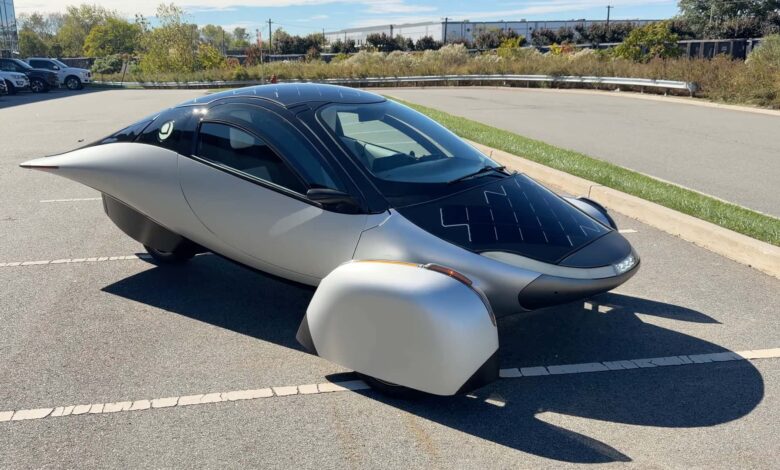Driving The Aptera Feels Normal—But Also Totally Alien

- YouTuber Marques Brownlee drives the Aptera three-wheeler validation prototype, revealing many of its unique traits.
- The vehicle in the video is very close to what Aptera intends to put into production starting next year.
- This is clearly a vehicle designed for warmer climates, since it doesn’t look like it would cope very well with ice and snow.
The Aptera three-wheeled solar-charging electric vehicle is what science fiction movies said cars would look like in 2025. It is so radically different from anything else on the road that even if it had four wheels, calling it a car wouldn’t do it justice. But it’s been in the works for years, and we’re still not sure if it’s actually going to make production.
Yet Aptera says it’s still in the game. And it lent one of its three-wheelers to someone outside the company to drive and document the experience. Marques Brownlee is that someone, and he made a video for his car channel called Auto Focus. He goes over the entire car, showing many details that we hadn’t had a good look at in Aptera’s official videos. It all seems to come together into a believable, production-ready package, even if it’s not all final or functional yet.
Who knew that the way to open the doors and the cargo hatch in the back is to double-tap on specific parts of the body? I’m not sure how practical that is compared to a normal door handle, but it certainly adds to the futuristic aura that this vehicle has, as does the exposed forged carbon fiber that you see when opening it up.
And speaking of cargo room, even though the Aptera looks like it wouldn’t be that practical, it actually appears to be. Marques has no problem fitting in the trunk and, in fact, you could probably fit two Marqueses in there with some space to spare. There’s even an additional, deeper storage space in the trunk, which you access by lifting a little lid, and there are also tie-down points where you could fit a net to prevent stuff from rolling around while you drive.
Sitting in the driver’s seat, it immediately becomes obvious how few physical buttons there actually are in the Aptera. There are two of them on the steering wheel and one for the hazard lights, but that’s literally it. You control everything else, including the electric windows, through the touchscreen, which is the first time I’ve ever seen that in a vehicle. This will stay this way for production, as will most of the interior that you see in the video.
One less positive aspect of sitting in the three-wheeler is outward visibility. There’s a thick border where the part of the side window that opens meets the part that doesn’t, and that’s in your line of sight. This does seem to impair over-the-shoulder visibility, although this will vary depending on the driver’s height. That’s why Aptera put the feeds from the side cameras on screens right in front of the driver, to make it as easy as possible to see what’s around.
Driving the Aptera is more normal than you may think—the fact that it’s a three-wheeler isn’t really obvious until you encounter a pothole that you can’t avoid—but the visibility issue does become more apparent. The fact that the car doesn’t end where the body ends is also unusual and you have to get used to the fact that the wheels stick out when threading it through a narrow space.
Even though there is a lot of skepticism regarding this vehicle making production, Aptera still says it’s on track and has been posting regular updates. The fact that it has gotten this far may be surprising to some, but the road to the actual start of production is still uncertain. The company says it wants to start making this vehicle “as soon as possible.” It’s currently in the validation stage and the plan is to begin limited production in 2026 and then ramp up production through 2028.
According to Aptera, there are over 50,000 reservations for this vehicle, which it plans to sell in four versions with up to 1,000 miles of range. You will also be able to choose between two sizes of solar array, providing up to 22 or 40 miles of free range daily.
The launch version will have 400 miles of range and a target price of $40,000, while the lower-range base model, planned for future release, will have 250 miles of range and cost from around $28,000.
Source link

